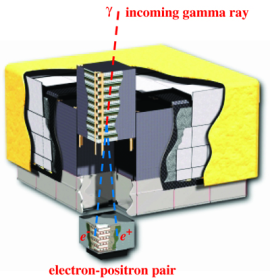The Fermi LAT instrument
This is a brief description of the instrument. For more details see the full technical description of the LAT and a summary of its performance.

Principles of operation
Unlike visible light, high-energy gamma rays cannot be refracted by a lens or focused by a mirror. Instead, they are detected with the same technology as the detectors used in high-energy particle accelerators.
Incoming gamma rays pass freely through the thin plastic anticoincidence detector, while charged cosmic rays cause a flash of light, allowing the LAT identify the relatively rare gamma rays. A gamma ray continues until it interacts with an atom in one of the thin tungsten foils, producing two charged particles: an electron and a positron. They proceed on, creating ions in thin silicon strip detectors. The silicon strips alternate in the X and Y directions, allowing the progress of the particles to be tracked. Finally the particles are stopped by a cesium iodide calorimeter which measures the total energy deposited. The information from the anticoincidence detector, tracker and calorimeter is combined to estimate the energy and direction of the gamma ray.

Construction
This cutaway view shows more details of the instrument's design. The 18 tungsten converter layers and 16 dual silicon tracker planes are stacked in 16 modular "towers" (37 cm square and 66 cm tall). Each of the 16 calorimeter modules consists of 96 long, narrow CsI scintillators, stacked in 8 layers, alternating in orientation so that the location and spread of the deposited energy can be determined. The plastic anticoincidence scintillator around the outside is made of 89 individual sections so that it can distinguish charged particles coming from the direction of the incident gamma ray and ignore others. A sophisticated, flexible data acquisition system combines information from all the components to decide when a likely gamma-ray has been detected and to choose what information to send to the ground. The upper part of the instrument is wrapped in a multilayer "blanket" which provides thermal insulation and protects from micrometeoroids and debris.
The LAT is 0.72 m deep and 1.8 m square. Its total mass is 2789 kg. It uses 650 W of electric power.
Calibration and Performance
Parts of the instrument were calibrated in particle beams at CERN, SLAC and GSI, but it was not possible to test the whole instrument with realistic gamma-ray and proton beams. The calibration relies on a detailed Monte Carlo simulation of all the instrument's components. The simulation software was refined until its predictions agreed with the results obtained from beam tests and cosmic ray muons.
The performance of a gamma-ray telescope can be characterized by its effective area, field of view and angular resolution. The field of view is very wide, with useful response out to about 60° from the instrument axis, covering about 20% of the sky. The angular resolution depends on the gamma-ray's energy, its incidence angle, and where it interacts in the detector. The point spread function for on-axis gammas has a 68% containment radius of about 3° at 100 MeV and 0.04° at 100 GeV. The effective area in the center of the field of view is about 7000 cm2 at 1 GeV, decreasing at lower and higher energy.
Operation
The Fermi spacecraft orbits the earth in about 96 minutes. It is oriented to point the LAT upward at all time, so the earth does not block the view. On alternate orbits Fermi rocks to the left and right, allowing the LAT to cover more of the sky. Thus the whole sky can be surveyed in two orbits. This mode of operation allows for constant monitoring of any gamma-ray emitter over days, weeks, months and years.
When a strong gamma-ray burst occurs, Fermi will point itself at the location of the burst for a few hours to collect extra data.
Subsystems
The LAT was produced as four separate subsystems which were built and tested separately:
- Tracker/converter (TKR): Technical description
- Calorimeter (CAL): Technical description
- Anticoincidence (ACD): Technical description
- Data Acquisition (DAQ): The best description is in the LAT instrument paper.
![]()

